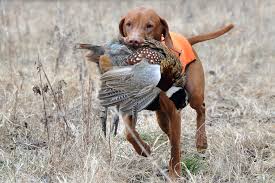 |
Hopefully this photo of Vizsla Kosmo of Fusion Vizlas retrieving a pheasant
will soon be replaced by one of Natasha Rose! |
While Jorge and I enjoy the hunt, we enjoy even more the gathering of friends at the dinner table to relive the adventures, brag about the accomplishments of our dogs and perhaps our own skills, and share in great meals of freshly prepared game. With our bird-dog, Natasha Rose at work along side Jorge, we expect to have many great celebratory meals here in Chile. But finding the right recipes for preparation of game can often be a challenge. Hopefully
Recipes/Recetas, the newly added page on Natasha's blog, will be of some help.
Recipes/Recetas hosts recipes of game, including pigeon and dove, rabbit, pheasant, duck, and others that we have enjoyed (or perhaps hope to enjoy next hunting season). As we are an international family living an expat life I hope to gather game recipes from around the world. Ironically, my cousin in Spain shared with me
Recetas Patagónicas con carnes de caza , a link to recipes from Patagonia, Chile! I also will be adding photos of food preparation and personal notes. I dare say the page may even grow into it's own blog with any luck. And who knows perhaps my own cookbook, taking me on to another journey!
And for those days where the aim is a little off or there were no critters to be found and you still want some meat on the table our friend Juan Castro shares this great resource for those of you living in Chile:
Carnes De Caza. According to their website:
The company was founded in 1995, becoming the first hunting ground of the V Region (also known as the Valparaíso Region). It is located in Fundo Los Pheasants Casablanca, which operates as an adventure travel company dedicated to hunting and fishing. They offer organic production of premium meats and fine gourmet haute cuisine and game birds, as well as exotic farming. They have recovered the old traditions of the Chilean countryside along with the true flavors of wild nature.
They are located at: 2 NORTE 1187 (Esquina 5 oriente) / FONO : (32) 2685 529 - 269 2913 - MOVIL 98016399 / TWITTER @avatte / VIÑA DEL MAR, CHILE
If you have other recipes you wish to share or links to them, please send them on to me and I'll be happy to add them!
